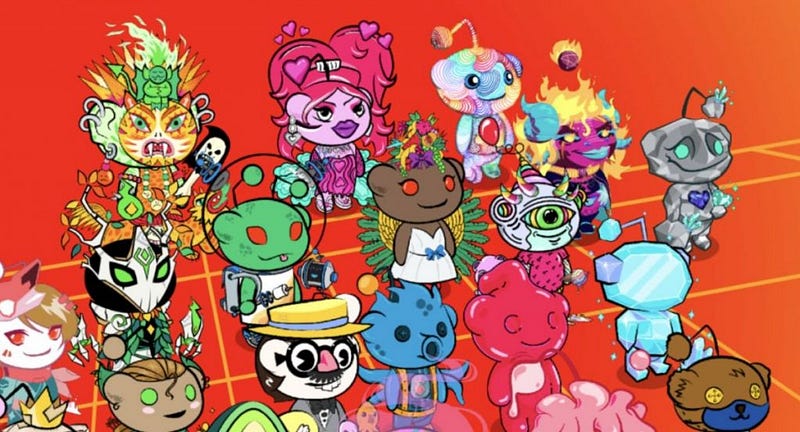
Last year was tough for the whole crypto world, however many brands in Web2 have been dabbling with NFTs as a signal of Web3’s resilience. The downfall of centralized crypto companies like Celsius, and FTX emphasized the need to shift from NFT price speculation to practical blockchain technology applications.
Now we have several Web2 brands focused on using NFTs to help transition into Web3. By integrating NFTs in their ecosystem or by rewarding customers with NFTs, brands have discovered new ways to monetize and improve customer loyalty and engagement. This trend, very different from the recent craze into meme coins, is slowly but surely revolutionizing the consumer/brand relationship.
Beyond the hype
NFTs are currently being explored by prominent brands and platforms such as Nike, Instagram, Starbucks, Twitter, Amazon, and Reddit, to name a few. Their unique technology enables digital asset origin tracking, making them perfect for the expanding creator economy. In this article, we’ll dive into the NFT implementation strategies of these three platforms and discuss the implications for content creators and consumers.

Let’s start with Nike, which is a great example of a non-crypto-native company making the digital leap. Nike had the most creative entrance to the space. The famous sports brand purchased RTFKT, a UK-based design studio on the cutting edge of phygital fashion and digital wearables. By acquiring RTFKT, Nike was able to create an immediate presence in Web3. Soon after the acquisition, Nike and RTFKT announced a partnership with famous fashion designer Takashi Murakami to create the CloneX NFT collection. Since then, Nike has continued to use RTFKT to release limited-edition Nike digital apparel and footwear and show no signs of slowing down.

Twitter’s NFT integration enables users to showcase digital collectibles as hexagonal profile pictures. Although it appealed to crypto fans, the feature was limited to paying users and had little impact on crypto Twitter. Even though the initial buzz faded away, many celebrities have publicly expressed their interest in NFTs. They have bought, invested, created various NFTs, and shared them as profile pics effectively attracting more eyes toward the space.
Conversely, Reddit launched a marketplace and profile picture collection of avatars, attracting 4 million new wallets. Reddit has been spearheading and simplifying Web3 adoption with a very straightforward approach, steering clear of complicated Web3 terminology and referring to the avatars as “digital collectibles.”

Instagram’s NFT integration is the boldest thus far, allowing users to display their digital collectibles and planning multi-blockchain integration across Ethereum, Polygon, Flow, and Solana. With a focus on user experience, Instagram could drive Web3 mass adoption by providing a seamless experience for its users. Unfortunately, even though this was all looking very promising, Instagram has decided to winding down and disable its digital collectibles features without offering any reasoning or justification for the decision.

Amazon, the world’s largest online retailer, is jumping on the Web3 bandwagon and is set to launch its NFT marketplace during May. According reports, the platform will focus on blockchain gaming and associated in-game NFT collectibles. This venture can be a significant milestone for blockchain and a huge step for NFTs and Web3 adoption.

Starbucks is another Web2 company making waves in Web3. The Seattle-based coffee company launched a customer loyalty program named Starbucks Odyssey last December. Starbucks fans could earn “Stamps” by completing daily tasks such as ordering specific items at Starbucks locations, completing online quizzes, etc. These stamps could then be used to get free drinks, discounted merchandise, and other perks. The program has been an overwhelming success and provided a fantastic roadmap for other companies looking to use NFTs to reward customers.

Will More Web2 Brands Enter Web3?
There’s a bright future for legacy businesses in Web3. A recent research from NFT Tech points to the consistent number of brands launching projects as evidence. While metrics such as Google search data for NFTs/crypto and the price of Bitcoin itself fell more than 50% in 2022, the number of brands entering the space only dropped 4.4%.

© NFT Tech
As NFT integrations become more mainstream, we expect a surge of new brands and creators from diverse backgrounds, with people focusing on the technology’s advantages rather than its complexities. For consumers, the expansion of NFTs on Web2 platforms can enable the “read/write/own” narrative of Web3, also allowing creators to more effectively monetize their work. To achieve this, brands/platforms must concentrate on refining the onboarding process, eliminating confusing jargon, and reducing barriers to entry for people new to the space.
In summary, the past year has been a challenging one for the crypto world, but Web2 brands have been exploring NFTs as a way to adapt and transition to Web3. Companies like Nike, Twitter, Reddit, Instagram, Amazon, and Starbucks have been experimenting and implementing NFT strategies to increase customer loyalty, engagement, and monetization. These integrations have focused on making Web3 technology more accessible and less complex for a wider audience.
As more Web2 brands explore Web3, we can expect to see a continued growth in the number of companies and creators entering the space. For this transition to be successful, it is crucial for these brands and platforms to improve the onboarding process, simplify the language, and reduce barriers for newcomers. Web3 is one of the greatest opportunities in modern history for innovative companies to develop new revenue streams and be at the forefront of a massively disruptive technology.
Worth keeping tabs on the developments from Web2 and Web3 companies alike to see what unfolds in the next phase of decentralized innovations.